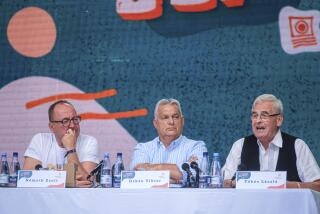Hungary Sees in ’96 Milestones of Founding, Revolt : Europe: The former Warsaw Pact nation sees its future with the West. Budapest, the capital, sparkles with new investment, but the countryside lags behind.
- Share via
BUDAPEST, Hungary — In the vibrant center of Budapest, cafes are crowded with businessmen chattering into cellular phones during working breakfasts. Manhattan on the Danube.
But, in a rustic tavern nearby, there’s an exotic touch of Transylvania, with musicians trading mournful riffs over a bottle of Tokay wine.
The old still mixes with the new as Hungary and its Central European neighbors strive for more identification with the West and struggle for free-market economies after decades under Moscow’s hard thumb.
Welcoming a chance to demonstrate where it stands, the Hungarian Parliament voted 312 to 1 in November to let U.S. and other NATO troops use Hungarian territory for bases for peacekeeping in the former Yugoslavia, a European neighbor. The vote was a historic step for a former Warsaw Pact member, the first to let Western alliance troops be based on its soil.
In the new year, though, Hungarians will be remembering their past.
Hungary stands alone as a nation descended from nomadic Magyar tribes from beyond the Ural Mountains. They arrived in the year 896, making 1996 the occasion of a “millicentennial” celebration.
The Hungarian state was founded in the year 1000 as a Christian nation under King Stephen, giving today’s Hungary another milestone coming up in four years to serve as a goal.
“The first Hungarian crown came from the pope, in the year 1000. Our goal is, with 1,000 years’ distance from the original date, to join the European Union,” said Laszlo Akar, deputy finance minister.
Akar said Hungary is taking final steps to liberalize its economy, which already had been the most free in the Soviet bloc with “goulash communism,” named after the paprika-laced national stew.
But the last steps may be the hardest, and pessimism is strong among the 10 million Hungarians. Strikes are spreading to protest falling living standards.
“This just cannot go on,” said Terez Illes, 39, a nurse who came to Budapest from the provinces in mid-November to join some 25,000 health workers demonstrating for wage increases.
She makes the equivalent of about $140 a month and says she couldn’t survive without money given by patients and their relatives. “I don’t know what I’d do without the tips.”
Out in the countryside, many people haven’t benefited from the investment that has put new sparkle on Budapest. The capital recently opened a new bridge over the Danube River, repaved the broad Andrassy Boulevard and refurbished the 100-year-old subway line that runs underneath it.
“Sometimes I wish I could go to Budapest,” said Lajosne Szabo, a 60-ish caretaker at a provincial museum. “Nothing is going on here.”
There are a lot of dignified country women like her in Budapest. You see them trying to sell their colorful embroidery to pedestrians on the graceful Chain Bridge linking Buda on the hilly west bank of the Danube with Pest on the flatter east bank. If they’re making a living at it, it doesn’t show.
After the democratic revolutions of 1989-90 in Central Europe, Hungary was the darling of Western investors who gave the country half the total invested in the region even though Hungary has only a fourth as many people as Poland, for example. The country appeared to be a half-generation ahead of Poland and the Czech Republic, but now those two countries are enjoying faster growth.
Hungary’s finances are said to be in dangerous imbalance, with net foreign debt ballooning $5.6 billion in two years to $18.9 billion at the end of 1994.
Akar, the finance minister, says the Hungarian people endured a 10% cut in real wages this year.
“For society, it is not easy to live with these developments, but I believe people can do it, though they may not be happy,” he says.
A happy Hungarian, however, might be a contradiction in terms.
“All Hungarians complain that Hungarians complain too much,” American author Eva Hoffmann writes in “Exit into History,” her recent book surveying the former East Bloc countries.
Hungary’s truly hard time came in 1956, too long ago for young Hungarians to find relevant.
Soviet troops in Budapest bloodily suppressed a revolt by brave rebels who came to be called the Freedom Fighters. Premier Imre Nagy, who had declared Hungary’s withdrawal from the Warsaw Pact, was later executed. He and hundreds of other victims of Stalinism lay in unmarked, overgrown graves for decades, though now that cemetery plot is becoming a national shrine.
*
In the 1970s, Hungarian communism softened. More free enterprise was permitted. The country shed its police-state image gradually and began to attract Western investment, while other East Bloc countries seemed to go backward.
“East Germany was two or three times as bad as our dictatorship in the later years,” says Andras B. Hegedus, 65, who spent two years in prison for his part in the 1956 revolt. Now he is director of the Institute for the History of 1956. It got start-up money from the American financier-philanthropist George Soros, who was born in Hungary.
Hungarians now have their first chance in centuries to reclaim the pride and fruits of full independence.
The Magyars had a kingdom that spread as far as the Baltic Sea in the 14th century and inspired their neighbors to pray, “God save us from Hungarian arrows.”
In 1526, the Hungarians lost a key battle to the Ottoman Turks, starting more than 400 years of domination by the Ottomans, Austrian Hapsburgs, German Nazis and Soviet Communists.
Against that long history of subjugation, Hungarians have started to flock to a restored panoramic painting that depicts the prideful arrival of the Magyar tribes in 896.
A chieftain with plumed helmet and hundreds of other animated figures on the giant canvas seem to stride from the past to confront crowds of hushed Hungarians who come by car and bus to the plains village of Opusztaszer, 110 miles south of Budapest.
The title of the painting--”The Entry of the Conquering Hungarians”--brings a wince to the face of Peter Deme, head of the Commemorative Commission supervising millicentennial events. He doesn’t like the overall title of the 1996 program: “The Anniversary of the Hungarian Conquest.”
“Our neighbors could complain,” Deme said. He’d prefer the title to refer to the “arrival” rather than “conquest.”
The title was thought up before he took the job, he said, and it was an idea of “people who don’t understand nationality problems in East-Central Europe.”
*
That is one of the things Hungary needs to get straight if it is to achieve its goals of joining the European Union and NATO. These organizations aren’t going to take in countries at odds with their neighbors. Hungary has a flagrant example on its western border: former Yugoslavia, whose wars and ensuing international trade boycotts damaged Hungary’s economy.
The painting is displayed around the inner wall of a rotunda. Viewers climb onto a central platform to gaze at the rounded canvas, 385 feet in circumference and 48 feet high. Loudspeakers carry a narration and sound effects. Drums and chants accompany shamans making a celebratory sacrifice and screams accompany Magyar warriors carrying off luckless local virgins.
The vast canvas was done by Hungarian artist Arpad Feszty a century ago when Hungary, part of the Austro-Hungarian Empire, celebrated the millennium of the Magyar arrival. Damaged in war, in storage for decades, the painting has been lovingly restored to star in Hungary’s 1996 celebrations.
It is visited daily by 2,000 people who pay double the cost of a movie ticket for 25 minutes to ponder a key event in Hungarian history.
Laszlo Szabo, an administrator at the site, conceded that some critics snipe at the historical reliability of the work. He compared it to a painting of Jesus walking on water. “You can believe it or not, but the painting stands.”
Hungarians have a way of surprising strangers by relating personal woes, and Szabo is no exception. His melancholy story could stand as a metaphor for Hungary’s plight in emerging from the Soviet realm.
Szabo studied for five years in the Soviet Union and became an agricultural engineer, but working with dangerous farm chemicals injured his throat. He had to give up his job, move back to his hometown and take a 50% pay cut, to $175 a month.
Hungarians have problems other than money. The country has had a low fertility rate since the 1960s, and the mortality rate has been increasing for years, so that the population is expected to decline by about 20% by the year 2040.
“The Hungarian mortality rate is much worse than the rest of Europe,” said Professor Rudolf Andorka, rector of the University of Economic Sciences in Budapest.
State-funded free health care is in a deep crisis. Nurses and doctors are poorly paid. Many hospital patients rely on their relatives for drugs, bed linen and tipping the medical staff.
“It is difficult to tell why mortality from heart attack and stroke have increased so much,” Andorka said. “We need better drugs and a more healthy way of life.”
*
Hungary is far from alone. Russia and other former East Bloc countries have experienced higher mortality rates since the political revolutions of 1989-90. Scientists are pondering what reasons lie behind these developments, and it may be years before convincing explanations are found.
“The great problem is, we really do not know the deep causes of the deterioration of mortality,” Andorka said, though the direct causes of some deaths--drinking and smoking--are easy to find.
On the bright side, the Hungarian work force gets high marks from foreign investors.
“The technical skills of college graduates in Hungary are outstanding, as high as anywhere in the world,” said Don McKenna, a native of New Jersey who is General Electric’s manufacturing director for Europe.
GE acquired Tungsram, Hungary’s light-bulb maker, and employs 8,300 in six factories. Hungary is becoming GE’s main European base, and McKenna said operations swung from a big loss in 1992 to profit in 1994 and 1995.
“We are now a very competitive business in key operating standards,” he said. Workers have stopped asking questions about new technology, he said. “Now the staff is asking, ‘How can you develop me?’ This is great.”
Post-communist Hungary has drawn on a trickle of returning refugees--or their offspring, such as Laszlo R. Czirjak, whose parents fled after the 1956 revolt. Born in the United States, he was reared speaking Hungarian at home but never thought he would use the language. Now 35, he has been in Budapest since 1992 as president of Bankers Trust Co.’s subsidiary in Hungary. He also is president of the local American Chamber of Commerce.
“It is a very rewarding feeling to be here, rewarding to bring together the two cultures. It makes me sleep better at night,” Czirjak said. “My parents had to leave here, but they were never negative about Hungary.”
More to Read
Sign up for Essential California
The most important California stories and recommendations in your inbox every morning.
You may occasionally receive promotional content from the Los Angeles Times.










